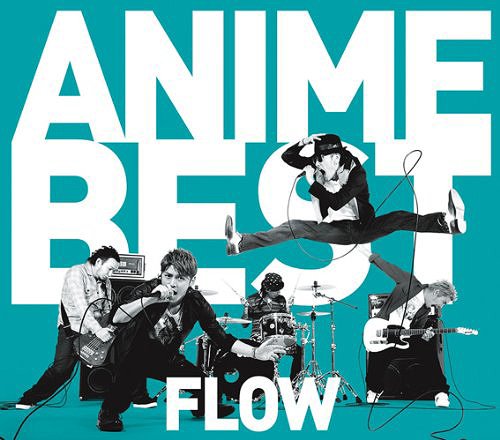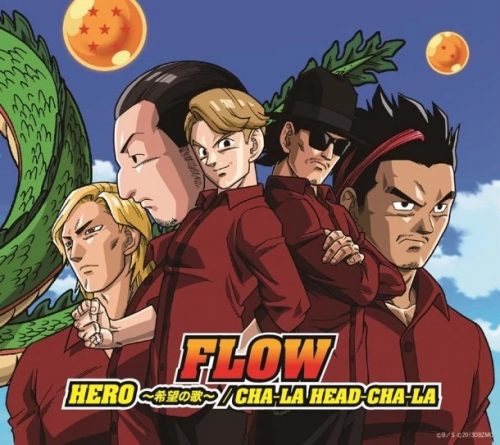
If you’re a fan of action anime, it’s very likely you’re familiar with FLOW as the anisong rockstars have been behind some of the most popular shows of all time. Blending in bits of pop punk and hip-hop to make a style of rock all their own, FLOW’s music has captivated many across the world and helped bring many anime openings to great heights. In this article, we’re focusing in on FLOW’s anisong contributions. Let’s GO!!!
A very short history of FLOW
FLOW is a five-man band consisting of vocalists Keigo Hayashi and Koshi Asakawa (who also plays rhythm guitar), lead guitarist and backup singer Takeshi Asakawa (Take), Hiroshi Iwasaki on drums, and bassist Yasutaro Goto (Got's). The Asakawa brothers first started playing together in 1993 as an X Japan cover band and later formed FLOW five years later with Hayashi and Goto. Iwasaki joined in 2000 and the group released their first single "Flow #0" the next year. They quickly became one of the most popular rock bands in Japan, with multiple high-charting releases. The name FLOW is derived from the word’s frequent use in hip-hop and the concept of flowing water.
Fun Time Delivery - FLOW’s Awesome Anisong
FLOW’s first foray into anime would be a big one when their singles "GO!!!" and "Re:member" were used as the fourth and eighth openings to the mega-popular Naruto anime. They would later return to the series with their 2010 single "Sign" as the sixth OP for Shippuuden.
FLOW’s next anime gig would be for BONE’S iconic music-inspired mecha series Eureka Seven with their 2005 single "DAYS" used as the first OP. Seven years later FLOW’s "BRAVE BLUE (ブレイブルー)" was chosen as the second opening to the follow up series Eureka Seven AO.
Losing no steam after "DAYS", the next year, FLOW would release what is arguably their most popular anisong, "COLORS"; the first opening to the wildly popular and acclaimed Code Geass: Hangyaku no Lelouch (Code Geass: Lelouch of the Rebellion). Two years later, they would provide the second opening, "WORLD END", for the second season, which was equally well-received as one of the best anime openings.
That same year, FLOW’s "Word of the Voice" would be used in the Persona 3 spin-off anime series Persona: Trinity Soul and in 2010 their song "CALLING" was used for one of Stan Lee’s anime projects, Heroman.
Coming into the modern era, FLOW remained active providing the third opening for Beelzebub, "Hey!!!". Their cover of Hironobu Kageyama’s "Cha-La Head-Cha-La" was used as the ending theme of Dragon Ball Z: Battle of Gods (as well as Dragon Ball Z: Battle of Z and Dragon Ball XenoVerse video games). Their 2014 single "Ai Ai Ai ni Utarete Bye Bye Bye" was used as the second opening to Samurai Flamenco.
Collaborating with fellow J-rock band GRANRODEO, FLOW would provide the second ED for Nanatsu no Taizai (The Seven Deadly Sins), "7 -seven-" as well as the first OP of the follow-up Imashime no Fukkatsu (Revival of the Commandments) with "Howling" this year. Before that, they also did the opening for Durarara!!x2 Ketsu, "Steppin' out", as well as "Kaze no Uta (風ノ唄)", "Innosense", and "BURN" which were used for the Tales of Zestiria anime adaptation as the first OP, third ED, and second ED of the second season respectively.
Final Thoughts

FLOW is one of the most prolific and respected musical artists working in anisong as well as one of the most popular bands out of Japan in general. With convention and concert appearances all over the world and a continuing legacy in modern anime openings, we expect FLOW to remain a big part of the medium we all adore and can’t wait to hear what they’ve got for us in the future.
We hope you enjoyed this article overFLOWing with anisong! Please leave us a comment below with your thoughts, memories, or favorite songs. Till next time, fighting dreamers!

